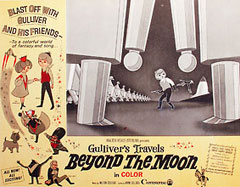Published: February 2006
The story of Gulliver’s Travels, the 1726 satirical novel by Jonathan Swift, is one of those plots that is taken up again and again by subsequent author-editors and teased into shapes that would have been unimaginable to the original author.
Evidence of the permutations forced upon Gulliver over the centuries can be found in a collection of materials that was recently donated to Boston College by William F. Cunningham, MA’56, a retired English professor from Creighton University in Omaha. The collection includes more than 200 editions of the book—the oldest from 1744—and more than 100 pieces of “Gulliveriana,” including playing cards, coloring books, and a blouse patterned with various scenes from the novel.
The borrowing of old narratives to serve new audiences is, of course, a familiar matter. Noah was not the first figure in prehistory to experience a death-dealing flood, and Shakespeare’s retellings and reuses of old material were multitudinous. And on it goes, through the singing, dancing Quixote in Man of La Mancha.
Sometimes, the adaptation is simply for a new audience. Gulliver was not written for children—in fact, it scandalized many of the adults who first read it—and the children’s versions that have been developed tend to focus on the first two voyages: to Lilliput and Brobdingnag. In the later voyages, Cunningham notes, Swift got “pretty nasty,” as in his depiction of the Yahoos, hair-covered humanoids with vile personal habits whom, however, the human Gulliver comes to recognize as kindred creatures. Or the adaptation may be to a different medium, like the Classics Illustrated comic books that were popular in the 1960s and that sometimes served students as shorter (and cheaper) versions of Cliffs Notes.
But retelling seems the lesser abuse when compared with the use of literary characters as pitchmen: winged Mercury selling flowers for FTD for more than 90 years, and countless Long John Silvers selling fried fish, and Gulliver marveling at the strength of cotton thread (it kept him tied to the ground).
For a filmmaker, the Gulliver story is promising because “he is not going to real places,” says Jeanine Basinger, chairwoman of film studies at Wesleyan University. Gulliver has also benefited from cutting-edge film technology: the 1939 version, from the Fleischer Studios, was the second animated feature ever released, after Disney’s Snow White. But Gulliver movies “have never been a success, oddly enough,” Basinger notes, often suffering from weak scripts—a terrible irony, given Swift’s wit.
As for the ephemera, she sees no harm in them. They are, she says, “a way of prolonging the joy of reading the book.” And what of Swift himself? “I think he’d be amused,” Cunningham says.

